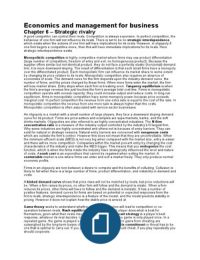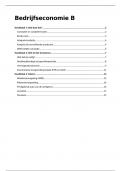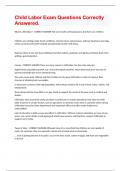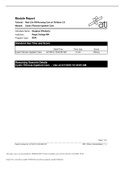Economics and management for business
Chapter 6 – Strategic rivalry
A good competitor can control their rivals. Competition is always expensive. In perfect competition, the
behaviour of one firm will not influence its rivals. There is set to be no strategic interdependence,
which exists when the actions of one firm will have implications for its rivals. However, in oligopoly if
one firm begins a competitive move, then this will have immediate implications for its rivals. Here
strategic interdependence exists.
Monopolistic competition is highly competitive market where firms may use product differentiation
(large number of competitors, freedom of entry and exit, no homogeneous product). Because the
supplier offers similar but not identical product, they do not face a perfectly elastic (horizontal) demand
line; it is more downward-sloping. The result of differentiation is that each small firms have a monopoly
over the differentiated product. Each monopolistic firm can influence its market share to some extent
by changing its price relative to its rivals. Monopolistic competition also requires an absence of
economies of scale. The demand curve for the firm depends upon the industry demand curve, the
number of firms, and the prices charged by these firms. When more firms enter the market, the firm
will lose market share. Entry stops when each firm is breaking even. Tangency equilibrium is when
the firm’s average revenue line just touches the firm’s average total cost line. Firms in monopolistic
competition operate with excess capacity; they could increase output and reduce costs. In long-run
equilibrium, firms in monopolistic competition have some monopoly power because price exceeds
marginal cost. In perfect competition the revenue form one extra sale is equal to the cost of the sale. In
monopolistic competition the revenue from one more sale is always higher than the costs.
Monopolistic competition is often associated with service sector businesses.
An oligopoly is a market with a small number of large players, they face a downward sloping demand
curve for its product. Firms are price-setters and examples are supermarkets, banks, and the soft
drinks markets. Oligopolies are also referred to as highly concentrated industries. The N-firm
concentration ratio is a measure of the industry output controlled by the industry’s N largest firm.
Why some industries are highly concentrated and others not is because of entry barriers. They can
exist for natural or strategic reasons. Natural entry barriers are concerned with exogenous costs
which are outside the firm’s control. However this does not mean that they are uncontrollable. When
the minimum efficient scale (MES) is not very big when compared with the market size, entry is easier
and there will be more competition. Companies within the market prevent entry by changing the cost
characteristics of the industry and make the MES bigger. This means that you endogenize the cost
function, which is when the firms inside the industry have strategically influenced the level and nature
of costs. A sunk cost is an expenditure that cannot be regained when exiting the market. A
contestable market is one where firms can enter and exit a market freely. They only produce normal
economic profits.
Firms in an oligopoly are torn between a desire to compete and the benefits of colluding. Collusion is
likely to fail when there is a large number of firms, product differentiation, and instability in demand and
costs.
A kinked demand curve shows that price rises will not be matched by rivals, but price reductions will
be. When a firm raises its prices, no other firm will follow and the demand is elastic. When a firm
reduces its prices, other firms will have to follow and the demand is inelastic. It has a number of
positive features: demand curves for firms are based on potential or expected responses form the
firm’s rivals, strategic interdependence is a feature of the model, and the model predicts stability in
pricing. However it does not explain how the stable price is arrived at.
Game theory seeks to understand whether strategic interaction will lead to competition or co-
operation between rivals. Nash equilibrium occurs when each player does what is best for
themselves, given what their rivals may do in response. A dominant strategy is a player’s best
response, whatever its rival decides. In a single-period game, the game is only played once. In a
repeated game, the game is played a number of rounds. Short-term gains from cheating are
outweighed by the long-term losses of a repeated game. A credible commitment or threat has to be
one that is optimal to carry out. If you play the game once you should cheat, if you play repeatedly you
should cooperate.
Chapter 6 – Strategic rivalry
A good competitor can control their rivals. Competition is always expensive. In perfect competition, the
behaviour of one firm will not influence its rivals. There is set to be no strategic interdependence,
which exists when the actions of one firm will have implications for its rivals. However, in oligopoly if
one firm begins a competitive move, then this will have immediate implications for its rivals. Here
strategic interdependence exists.
Monopolistic competition is highly competitive market where firms may use product differentiation
(large number of competitors, freedom of entry and exit, no homogeneous product). Because the
supplier offers similar but not identical product, they do not face a perfectly elastic (horizontal) demand
line; it is more downward-sloping. The result of differentiation is that each small firms have a monopoly
over the differentiated product. Each monopolistic firm can influence its market share to some extent
by changing its price relative to its rivals. Monopolistic competition also requires an absence of
economies of scale. The demand curve for the firm depends upon the industry demand curve, the
number of firms, and the prices charged by these firms. When more firms enter the market, the firm
will lose market share. Entry stops when each firm is breaking even. Tangency equilibrium is when
the firm’s average revenue line just touches the firm’s average total cost line. Firms in monopolistic
competition operate with excess capacity; they could increase output and reduce costs. In long-run
equilibrium, firms in monopolistic competition have some monopoly power because price exceeds
marginal cost. In perfect competition the revenue form one extra sale is equal to the cost of the sale. In
monopolistic competition the revenue from one more sale is always higher than the costs.
Monopolistic competition is often associated with service sector businesses.
An oligopoly is a market with a small number of large players, they face a downward sloping demand
curve for its product. Firms are price-setters and examples are supermarkets, banks, and the soft
drinks markets. Oligopolies are also referred to as highly concentrated industries. The N-firm
concentration ratio is a measure of the industry output controlled by the industry’s N largest firm.
Why some industries are highly concentrated and others not is because of entry barriers. They can
exist for natural or strategic reasons. Natural entry barriers are concerned with exogenous costs
which are outside the firm’s control. However this does not mean that they are uncontrollable. When
the minimum efficient scale (MES) is not very big when compared with the market size, entry is easier
and there will be more competition. Companies within the market prevent entry by changing the cost
characteristics of the industry and make the MES bigger. This means that you endogenize the cost
function, which is when the firms inside the industry have strategically influenced the level and nature
of costs. A sunk cost is an expenditure that cannot be regained when exiting the market. A
contestable market is one where firms can enter and exit a market freely. They only produce normal
economic profits.
Firms in an oligopoly are torn between a desire to compete and the benefits of colluding. Collusion is
likely to fail when there is a large number of firms, product differentiation, and instability in demand and
costs.
A kinked demand curve shows that price rises will not be matched by rivals, but price reductions will
be. When a firm raises its prices, no other firm will follow and the demand is elastic. When a firm
reduces its prices, other firms will have to follow and the demand is inelastic. It has a number of
positive features: demand curves for firms are based on potential or expected responses form the
firm’s rivals, strategic interdependence is a feature of the model, and the model predicts stability in
pricing. However it does not explain how the stable price is arrived at.
Game theory seeks to understand whether strategic interaction will lead to competition or co-
operation between rivals. Nash equilibrium occurs when each player does what is best for
themselves, given what their rivals may do in response. A dominant strategy is a player’s best
response, whatever its rival decides. In a single-period game, the game is only played once. In a
repeated game, the game is played a number of rounds. Short-term gains from cheating are
outweighed by the long-term losses of a repeated game. A credible commitment or threat has to be
one that is optimal to carry out. If you play the game once you should cheat, if you play repeatedly you
should cooperate.












